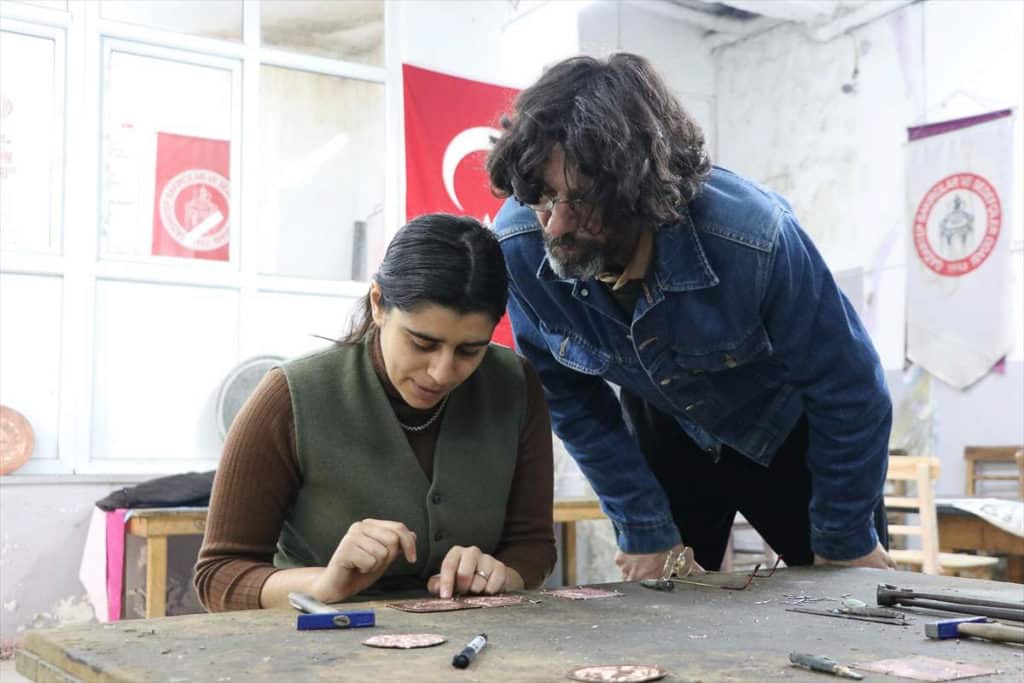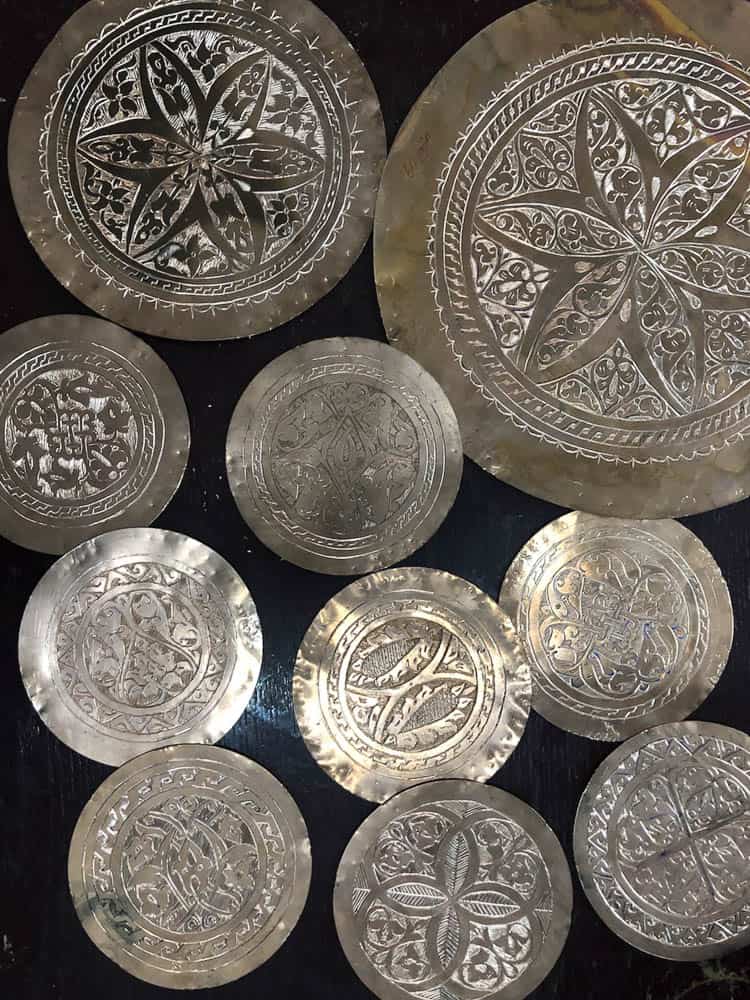
The Hittite castle, Roman 200AD, overlooks the civic centre from a lofty position upon a hill in the old city. It’s a monolithic talisman to ward off the infection of mass consumption and gross imitation. The castle’s simplicity of form and overpowering sense of weight feels as though it has grounded the old city and provided a haven for the rich continuation of the artisan practices in the centre of town. Its hues present a welcoming complexion, pale sand tones reflect the golden sun on a clear day, a warm sensory feeling of progression in the hands of fluid cultural tradition.

Cobblestoned alleyways and cavernous heritage spaces turned studio/showrooms pulsate with energy, both authentic and collectively owned, but without a hint of hype. The spectacle is an honest one. Ambience emanates from the enduring presence of an exquisite decorative practice. The tapping of the artisan accompanies lively conversation. The cats with their white fur coats dulled by a soft ashen dusting, bear the characteristics of the coppersmithing artisans. Their gritty magnetism and energetic wily playfulness is the heart of old Gaziantep in Turkey.
The Copper Tinsmith and Narce Association of Gaziantep is situated on an intersection adjacent to a sandwich nook. This tiny hole in the wall is home to the most delicious eggplant and spiced chickpea wraps in Turkey. The street frontage occupied by the association’s retail space is a mesmerising lustre of metal finishes, featuring a countless array of objects housed on shelves, floor space and suspended from the ceiling. Arabesque motifs adorn all copper surfaces. Inside feels like the interior of a large conservatory for metallic fauna and flora. The motifs are organic and floral motifs entwine with deers and birds. There is a depth to the symbolic representation and relationship, harmony and spirituality expressed through the refined execution of lines which have the eyes swirling like a dervish performer.
Standing inside the shop, submerged in the shimmering metallic wilderness, an earthly rhythmic tapping rises up from beneath us. Downstairs in the workshop are seated six artisans, clustered in front of a glass double door entrance, the primary source of natural light. Each positioned before a vice actively engraves a vessel for domestic or commercial use, either a commemorative tray, coffee set or one of many various decorative objects. It appears to be one of the most stress-free work environments imaginable. Tucked in a corner behind one of the senior artisans is an old radio charging the studio with a rich ambience of classical Turkish music and Turkish renditions of classic Arabic tunes into the workspace. A diverse age demographic of artisans makes up the group. The musical choice alludes to generational preferences: the more senior swept up in colourful exuberant singalongs, while the younger guys sit with their headphones on!
Cement steps descend further into a dimly lit space. Dim fluorescent lighting evokes an early twentieth-century bunker, revealing an interior palette of grey tones and industrial marks, worn floor tiles, and tables and chairs. The furnishings are eclectic, solid and functional. It feels emancipating that the possibility of gaining insight and training will be unobstructed and less complicated by too many OH&S standard practices. Numerous Turkish flags, locally made from cloth of a rich vibrant red, are suspended from the ceiling, and many fine examples of arabesque copper works are layered up against the walls. A lathe operator situated in a dark corner of the room forms the objects to be engraved by the professional artisans and the workshop’s training school. A jinn seems to appear screeching and grinding whenever an object is being formed with the desired heavy steel tool designed to craft it. Salman the head coppersmith emerges from somewhere behind the lathe operator to greet us, he is very warm with a jovial candour, and much like the community of Narce Association, relaxed, very open and supportive. With 33 years of experience, his guidance in the coming weeks is, of course, a unique opportunity.

Our first session; engraving a straight line. Learning the engraving technique is the point of the exercise, as then a straight line should be of little consequence!! He teaches the correct way to hold the steel engraving tool and the angle on which to hold the tool in order to remove the appropriate amount of copper without going too deep or remaining too shallow. The hammer tapping is of paramount importance to the fundamental technique of engraving a smooth line: symmetry is very important. The tap has to be quite firm and there has to be a constant steady flow to ensure the line is engraved even throughout.
Salman effortlessly sketches intricate patterns with impeccable symmetry. These are guidelines for us to follow on squares of sheet copper, as three-dimensional forms are certainly not within my skill set at this point. The small curves within the floral forms require a new set of muscle memory skills. To achieve fine tight arcs requires learning to move from the wrist almost three hundred and sixty degrees—to perhaps become double jointed. The movement must be fluid, exercising one continuous motion in order to achieve the tight arcs.
Throughout the coming weeks, we approach some prevalent designs which form the foundation of Turkish arabesque design practice in Gaziantep. Each new design element requires slight variations and more refining of fundamentals. Circles are quite painful at first due to unfamiliar hand movements and a continuous flow of tapping required for a smooth and symmetrical form. Circles are engraved for all border patterns. Finishing effects applied to negative space around the motifs helps the background recede. This is usually one of two techniques, the first is cross-hatching where the outcome is a diamond effect which is slightly raised almost resembling the texture of pineapple skin. The second consists of diagonal lines which are very straight and close together. The lines are not as deep as when engraving motif lines and lightly score the surface, the technique removes most of the surface so it catches very little light and appears quite dark.
A composed and self- possessed temperament coupled with a graceful dancer’s sense of rhythm and flow is certainly an advantage in order to be able to execute the smooth fine lines that embrace each copper object. Arabesque curves fold into themselves and playfully lose you in their intricate garden of interwoven elegance. The engraving technique demands a sensitive touch and a lightness of being. Heavy cumbersome lines tend to amass upon the object like tragic scars and kill the allure of the arabesque very quickly. Throughout the morning, one of the artisans brings in a tray of tea, so we sit for a few minutes.
In society today I feel individuality is heralded as an ever-increasing virtue. I walked away from the coppersmiths of Gaziantep feeling that the value inherent in craft is exclusively the weaving of individuals and small groups of humans into a community and intentionally a healthier cultural body. Without the artisans, I imagine a community’s existence to be lost and soulless, inept of the ability to nurture human needs. The difference an artisan’s practice can bring to a community through its tactile nurturing of skill-based sharing is very apparent in Gaziantep. Thank you Narce Association for the incredible insight into the craft and artisans of Gaziantep.
Author
 Shireen Taweel is an artist currently working from the Parramatta Artist Studios in Sydney. She predominantly works in installation and multimedia. The material of copper has been a core element of her practice so far, with the acquisition of artisan skills being a research vessel for conceptual development. More information about her recent projects can be viewed on her website at shireentaweel.com. Shireen Taweel’s residency working with the coppersmiths of Gaziantep was supported by The Australian Council For The Arts, The Parramatta Creative Fellowship Fund, and The Freedman Foundation Traveling Scholarship.
Shireen Taweel is an artist currently working from the Parramatta Artist Studios in Sydney. She predominantly works in installation and multimedia. The material of copper has been a core element of her practice so far, with the acquisition of artisan skills being a research vessel for conceptual development. More information about her recent projects can be viewed on her website at shireentaweel.com. Shireen Taweel’s residency working with the coppersmiths of Gaziantep was supported by The Australian Council For The Arts, The Parramatta Creative Fellowship Fund, and The Freedman Foundation Traveling Scholarship.






